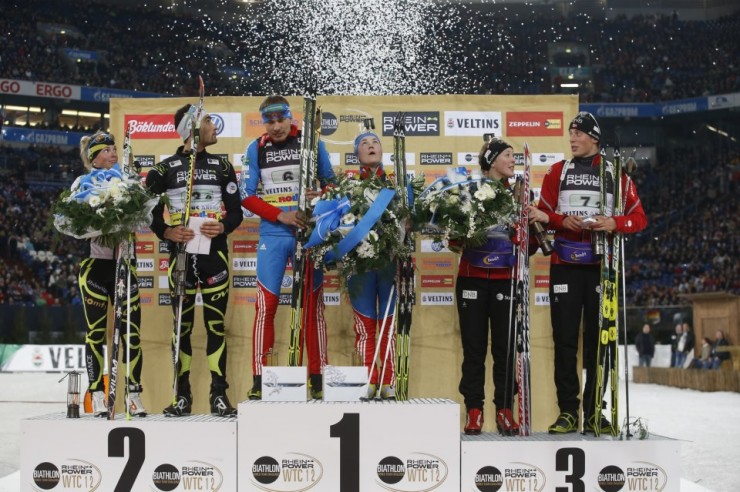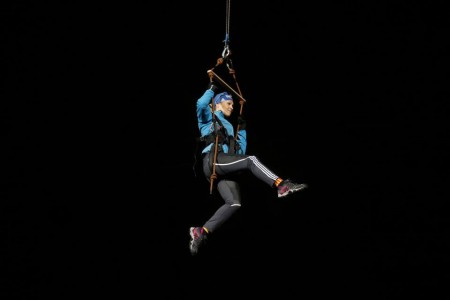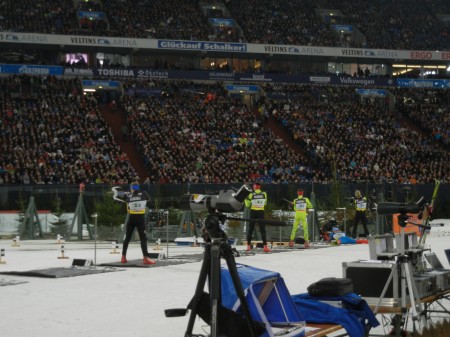
Who would think of holding a biathlon race inside a soccer stadium with 50,000 fans?
Who would think of dropping retired German star Magdalena Neuner into the stadium on a trapeze, while the theme from the James Bond film “Skyfall” blared in the background?
Who would think of asking elite biathletes to do three competitions in a single day?
The answer to all of these questions is the organizers of the RheinPower World Team Challenge 2012, an event that has been held at the Veltins Arena in Gelsenkirchen, Germany, for the last ten years. Usually the home of the FC Schalke 04 football club, the arena was outfitted with plenty of snow, a bridge, a tunnel, and a shooting range backed by bulletproof glass so more spectators could be crammed in to watch.
“[I’ve] never seen anything like it,” U.S. biathlete Susan Dunklee told FasterSkier after completing her first World Team Challenge on Saturday. “Very loud, but dark in the stands so it was easy to zone the crowd out. It became one roaring creature rather than thousands of individuals.”
And the day wasn’t just about biathlon; there was also a celebrity shooting competition (won by Alexandra Popp, the striker of the German football team) and plenty of other entertainment.

But biathlon was the centerpiece, including a farewell to Neuner, who retired at the end of last season as the second-winningest woman in the history of the sport. After her special entrance, she highlighted a women’s-only race – which was actually won by Dorothea Wierer of Italy by three seconds over Neuner, with each accumulating three penalties. Wierer meant to wait at the finish and let Neuner cross before her, but ended up slipping across the line first anyway.
There was also a tribute to Michael Greis, another German star who announced his retirement after the first few competitions of this World Cup season. With 11 World Cup wins, he was ninth on the all-time list.
The main competitions consisted of teams of two athletes, generally from the same country although Carl Johan Bergman of Sweden and Kaisa Makarainen of Finland joined forces again after winning a previous edition of the World Team Challenge.
First, they competed in a “shoot-out,” to see who could clean four stages in a row, prone-standing-prone-standing, the fastest. Spare rounds are allowed to hit targets that were originally left standing. There was no skiing involved and results haven’t been published online, but Dunklee reported that she and teammate Tim Burke each finished in the middle of the pack.
“The shootout didn’t really count for anything, it was just something they have for the show and for fun,” Dunklee wrote in an e-mail. “It is very similar to a drill we do in the summer called the ‘American Test.’ We do it a little differently in practice; we don’t use spares and if you miss more than three you are DQ’ed. During the competition, I did get a little shaky and over excited trying to load the spares, which is great practice for relays.”

After a little break the teams faced a mass start competition unlike anything they will ever see on the World Cup. Much like a cross country sprint relay, each member of the team skied a loop and shot before tagging off to their teammate. But the men and women each did four laps of the 1200 meter track, which wound outside of the stadium after exiting via a tunnel, as well as penalty loops if they missed shots.
In the mass start, the women started on the range, as well, so had an extra prone stage. That made a total of 45 targets for each team in the race – hence the higher-than-usual penalty counts that would seem staggering on the World Cup.
The French team of Marie Dorin Habert and Martin Fourcade won the mass start by 1.6 seconds over Vita Semerenko and Sergey Sednev of Ukraine. Fanny Well-Strand Horn and Lars Helge Birkeland of Norway were third. Dunklee and Burke were ninth out of ten teams. (Field size was limited by the ten-point range that could fit inside the arena.)
Just an hour and a half later, the teams lined up again, this time for a pursuit based on the results of the mass start. 40 more shots, and a lot more small loops awaited them.
“I have never done a biathlon race with quite so much lactic acid in my system,” Dunklee wrote. “It was a lot like a xc sprint relay.”
The French held onto the lead for most of the race, but at the end were passed by Ekaterina Yurlova and Anton Shipulin of Russia, who took the overall crown. The Norwegians were third again, followed by Andrea Henkel and Andi Birnbacher of Germany; the Americans slipped to tenth.
That was despite near-perfect shooting by Burke, said Dunklee.

“Tim shot awesome (4 misses total between the two races),” she explained. “I struggled with one disaster stage of four misses during each of the races. But I felt good that majority of my stages were 0’s or 1’s despite the head to head pressure, the jetlag, and hearing my name over the loudspeaker.”
Unlike Burke, who has competed at Schalke before, Dunklee was a newbie to the strange formats, 1200 meter loop, 100-meter long tunnel leading to the outdoor portion of the course, and all the rest.
While both suffered from jetlag, Dunklee had a particularly tough transition to German time: she had been scheduled to fly out two days before the race, but her flight was canceled due to the winter storm that pummeled the east. As such she arrived at 7 a.m. and left to race at 3 p.m., with just a few hours to relax and adjust in between.
“As soon as I entered the arena, adrenaline kicked in and woke me up,” Dunklee wrote.
All in all, the experience was unique, she said, but not completely irrelevant to regular World Cup racing.
“My goal was to enjoy the experience and treat it was a learning and training opportunity,” she wrote. “The crowds are huge and the head to head pressure on the range defines this event. The more I can expose myself to things like this, the more prepared I will be for the World Cup. Dealing with pressure on the range is something you must learn by doing… My shooting groups crept higher and higher as my system became more stressed and I started overheating. That created another great opportunity to understand myself better as a shooter – my race groups of shots may differ from my zero.”
Dunklee shared a video touring the Schalke course, which can be seen at the link on YouTube.
The IBU World Cup resumes in Oberhof, Germany, on Thursday with a women’s relay. A men’s relay follows on Friday and then sprint and pursuit competitions will be held over the weekend.

Chelsea Little
Chelsea Little is FasterSkier's Editor-At-Large. A former racer at Ford Sayre, Dartmouth College and the Craftsbury Green Racing Project, she is a PhD candidate in aquatic ecology in the @Altermatt_lab at Eawag, the Swiss Federal Institute of Aquatic Science and Technology in Zurich, Switzerland. You can follow her on twitter @ChelskiLittle.



